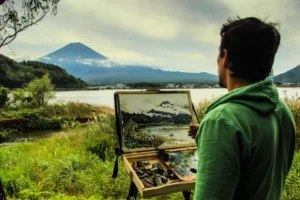Obon (お盆) festivals include Bon Odori, dance celebrations officially held from August 13th to 16th during the Japanese summer. These dates follow the lunar calendar and change yearly, especially when the lunar and solar calendars match. Although the exact times vary from region to region, it is commonly believed that ancestors’ spirits return at this time.
Some of these summer festivals have been taking place for centuries. For example, the Gujo Odori in Gifu and Awa Dori in Tokushima have been ongoing for over 400 years. The Nishimonai Bon Odori in Akita is so old that its history is unknown. However, most people use the holiday to return to their hometowns.
At these festivals, they wear their yukata and light cotton kimono to temples, make food offerings, and welcome family members. It’s a busy time to be traveling. But most communities in Japan take part, so you usually don’t have to go far to take part. Here are some festivals that will take place in the Tokyo and Kanagawa areas in August.
Table of Contents
ToggleGujo Odori (Gifu)
The Gujo Odori festival is celebrated in Gujo, Gifu Prefecture, and is one of Japan’s most significant. It started over 400 years ago during the Tokugawa Period to unite townsfolk of every social status, and this theme continues today.

Various floats transport live singers, accompanied by musicians playing traditional instruments like the shamisen and taiko drum. Ten dances are featured. “Kawasaki” is the most popular, along with its older version. But there are also “San Byaku”, “Yachiku”, “Gen Gen Bala Bala”, and “Sawagi”, to name a few. The “Neko no Ko” (“kitten” dance) mimics the actions of a young cat. This is one of the longer bon festivals in Japan, lasting thirty-two nights from mid-July to early September. Unlike other similar celebrations, the dancing continues all night from August 13th to 16th.
Tsukiji Hongwanji Bon Dance
Taking place from August 2nd to August 5th, the site of this free festival truly deserves recognition. This Buddhist temple was constructed in Asakusa in 1617 but burnt down 40 years later. It is said that devotees created the land at its present spot on the Sumida River by hand (“Tsukiji” means “reclaimed land”). Unfortunately, the temple was destroyed again, this time by an earthquake. It was then rebuilt (again) in 1934.

This backstory adds historical importance to this gathering. The temple’s size and unique design were responsible for its designation as an official cultural property of Japan. Between 6 pm and 9 pm, hundreds meet around the stage (yagura) in the courtyard under lanterns. Singers perform the local song “Tsukiji Ondo” and accompany it with music. One unique aspect of Tsukiji Hongwanji is the strange costumes some participants wear. Another is its location in the Tsukiji restaurant district, which guarantees tasty street foods.
Are you looking for great snacks in time for Obon season? Check out Sakuraco! Sakuraco delivers traditional Japanese snacks, teas, and sweets from local Japanese makers directly to your door so you can enjoy the latest treats directly from Japan!
Awa Dori (Tokushima)
This 400-year-old festival’s name is derived from the former name of Tokushima Prefecture, “Awa”. The entirety of Tokushima’s City center is closed off for the event. Professional and amateur dance groups (ren) from as far away as the United States elaborate on the original dance with their signature moves. They also distinguish themselves with matching yukata, happi, and original music performed on Japanese instruments.

This event will occur from August 12th to 15th, with the best performances between 6 pm and 8 pm. The event is free, but better views of the stage can be had from the paid viewing area. These tickets can cost anywhere from 1,000 to 15,000 yen.
Kabukicho Bon Dance
This mid-August event is another fusion of new and old. It will feature a mix of classical songs and modern music. Everyone is invited to take part. The date has not yet been announced, but festivities will likely begin at about 4 pm. Registered dancers will meet at an unspecified location and approach the Cine Square in Kabukicho.

From 6 pm to about 9 pm, instructors at the square will teach newcomers the city’s dance style. Cine City Square is a large plaza conveniently located near many stations. Seibu-Shinjuku, Higashi-Shinjuku, Shinjuku-Nishiguchi, and Shinjuku Stations are all within walking distance.
Nishimonai Bon Odori (Akita)
The Nishimonai Bon Odori is held annually in Ugo Town, Akita Prefecture, from August 16th to 18th. This is one of Japan’s top three Bon Odori festivals, with a 700-year history. Dancers wear dark, indigo-colored yukata and matching headwear. And their faces are covered with a particular veil known as hikosa zukin.

The somber music and nearby bonfire make the performers’ mysterious display even more captivating. As a result, their dance is known as “mojo odori” or “dance of the dead.” Because of its history and uniqueness, the Nishimonai Bon Odori is designated as an Important Intangible Folk Cultural Property of Japan.
Why is the Bon Odori important in Japan?
Bon Odori is the most important festival in Japan. It also honors lost family members and brings communities together through traditional dance, music, and customs. Finally, you can connect with locals and learn about the spiritual beliefs of Japanese society. Have you visited any of these festivals? Which is your favorite? Do you know of any other similar gatherings that we should mention? Let us know below!











